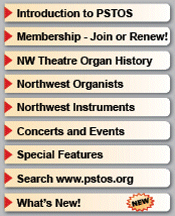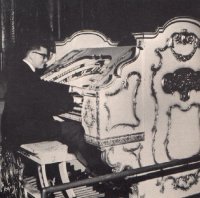


 |
||
|
Three Loves Has Schrum - Seattle Paramount Wurlitzer Excerpt from Theatre Organ magazine, Summer 1964 (V6 No 2, pp16-18): THREE LOVES HAS SCHRUM Seattle Paramount WurliTzer by Dick Schrum My third big love affair started for real in 1960. She is the most beautiful blond imaginable. Of course I mean the big, white and gold 4m/20r WurliTzer in the Paramount Theatre, Seattle, Washington. My first affair was with a 3m/10r Morton in the Tacoma Roller Bowl, where I cut my organ teeth - and which I recently acquired for my very own. The second, and biggest affair was and is with my wife Marilyn. When I first moved to Seattle in the fall of 1960, I had only played the Paramount organ once, and only a short time at that due to the feeling of the management. I later found, to my joy, that the manager of the 5th Avenue Theatre had been transferred to the Paramount. The only obstacle to overcome now was the stagehand who claimed that the lift fuses kept blowing every time the organ lift was used. We were able to get around this by agreeing not to use the lift.
Hardly anyone knew that the piano even existed, and the little slave console somehow had made it as far as the Music Box in Tacoma. Then, the end was apparently at hand. My heart stood still when I heard the theatre was going Cinerama, which meant that the pit would be covered over, and also part of the organ chambers. Disaster! About this time, things began happening. I found that the screen would not be permanent! I also found the air leak was actually the surf effect on the swingout effects panel under the console cheek. The management was elated that someone really took an interest in the organ. One good thing came out of their bout with the wide screen-the drapes came down from the chambers, new seats were installed, the theatre completely cleaned, and what a difference in sound. We found that the lift motor needed at least 30-amp fuses-previous technicians had been using 10! With the help of fellow ATOE members Bob Jones, Roger Johnson, Don French, and Northwest Organ Service's Clark Rush, we started on dead magnets. Lo! This thing was completely black cap!! After learning how to replace them I spent many mornings by myself prying and replacing. We surveyed the piano and decided to just forget it; after at least 15 years of disuse it was in terrible shape. We regulated tremulants, my idea being to get as close to what Jesse Crawford used as possible. Clark worked over the generator, and the stage hand and I installed a V-belt drive and re-positioned the generator next to the blower. Luckily, the theatre wasn't opening until eight at night during the week, so we had time to tune. My patient wife didn't object too loudly, and even helped 'Mr. Clean' the console. It turned out amazingly beautiful except for the usual cigarette scars - and the bench didn't hold up too well for looks. Now it was ready for the public. One interesting fact about the organ is that over the years it remained in extremely good tune, with the aid of Clark Rush who has the quarterly maintenance contract. Quarterly maintenance meant that he was to check that the organ was still there and run it a while. He is to be credited with doing a lot of free tinkering over the years just to keep it running. In March of 1963 I was contacted by the Granada Organ Loft Club, and we dreamed up a fund raising concert. Why not the Paramount? It was ready. So arrangements were made for Saturday night, April 6th, for the first public concert on this organ in some 20-odd years. Lights were installed on the pedal board under the bench, and at the last minute I decided to restore the Chrysoglott. I also managed to acquire a Howard Seat from ATOE member Don Meyers for the event. Most people I talked to didn't realize that this organ even existed! All money received was to go to the Granada Club, which had just acquired a theatre and was preparing to install the former Portland Liberty WurliTzer. The Paramount console has a large gold basket of roses on each side - so naturally my opener would by "Everything's Coming Up Roses." Well, I tell you, that was a mistake! I didn't get out of the pit for 10 minutes. That morning there was a style show and preview of "Bye Bye, Birdie," and the organist, who didn't pIay pipes, had three electronics and two pianos in the pit. This wasn't enough; he had to raise "The Doll" up so he could have a phone bell for a skit on stage. Afterwards he proceeded to blow every fuse on the lift. No one knew about the dead fuses until I didn't show myself immediately that night. At least I had the mike on the lift, and two stagehands, the manager and division manager of the chain holding everything together until I finally made it. Then I didn't dare go down for the silent film so I played while leaning around the edge of the console. Fortunately it is in the left side of the pit. After the initial troubles settled down, the concert progressed rather smoothly, but those first few minutes, WOW! At about 2:30, I put her away and quietly came unglued. The next public performance was during 'National Live Music Week" of that year, when I played all weekend at intermissions prior to my night-club job. This spring I world premiered a French show-all type show, starring Elke Sommer. Very culturedly uplifting, to say the least! Then chilling news hit! I was told that the organ had been sold! So, another farewell concert seemed the only thing to do. After playing out the Music Hall Morton in November, I felt that losing two of the best organs in town would be a musical calamity! But, fortunately, the theatre people took another look at the over-all picture, and removed the organ from the market indefinately. The concert then turned into a celebration. Music Hall executives have been extremely sorry since they sold the Robert Morton the house is now in steady use for road shows and musical events, and the organ would be welcomed. So, Wednesday, May 6, 8 p.m., was the big blast. Everything worked beautifully, and the stage crew knocked themselves out with unusual lighting effects. Everyone tells me the big hit of the concert was the medley of memory tunes, with all lights out except those on the console, making the organ the real star. Since the theatre has changed hands several times, much of the old records, programs, pictures, etc., have been lost. But it is a 3,000 seat house, opened in the fall of 1928, and the most notable organists were a duo called Ron and Don. They employed various effects with the two consoles, such as: the organ would rise out of the pit with no one seated at it, yet playing wildly. Don would be in the pit with the lights out playing furiously as Ron stepped from the curtain bowing and pointing to the console. Then the spot would shift to Don at the slave console. Another story from an ancient employee concerns a portable short keyboard on a long cable attached to the Great manual. Ron would walk up the aisle taking requests, start the tune with a one finger melody, and Don would immediately fill in the accompaniment from the console. Another noted organist, the late Oliver Wallace, did a short stint according to my info. The second console's whereabouts is unknown, presumably burned in the tragic Tacoma Music Box fire. At this writing the Paramount organ has definately not been sold, and plans are afoot to restore the piano. One unfortunate thing, though, the management does not want to be bothered with anyone recording the organ commercially. I guess concerts are enough trouble for them! SEATTLE PARAMOUNT FACTS Seattle's Paramount WurliTzer is a standard 4m/20r Publix, with the usual traps, pizzicato, etc. The pedal section is in a separate chamber over the main chamber on the left side. Relays, piano, and master xylophone are placed over the solo chamber on the right. The solo chamber has one 16 ft. stop, the Tibia. Other organ facts: 10 hp Spencer Orgoblow at 1800 rpm; V-beltdrive generator; piano and master xylophone are unenclosed, and there is a black glass music rack, but ugh! It ruins the looks of the console completely, and who needs it? (Author Schrum answered this by writing: "We all do at times.") ABOUT THE AUTHOR Author Dick Schrum is currently Chairman of Puget Sound Chapter - a big job in itself. He also plays a Seattle night spot and manages to teach, work in a music company, play concerts on theatre organs (Farewell Music Hall Morton plus several Paramount recitals), maintain a home and keep a WurliTzer Widow happy. This requires more than vitamins--he is a thoroughly dedicated organ buff.
|
| About this site | © PSTOS, 1998-2010 |
